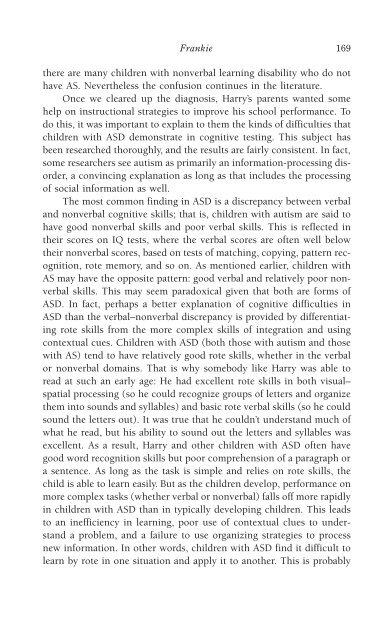978-1572305441
autism
autism
Create successful ePaper yourself
Turn your PDF publications into a flip-book with our unique Google optimized e-Paper software.
Frankie 169<br />
there are many children with nonverbal learning disability who do not<br />
have AS. Nevertheless the confusion continues in the literature.<br />
Once we cleared up the diagnosis, Harry’s parents wanted some<br />
help on instructional strategies to improve his school performance. To<br />
do this, it was important to explain to them the kinds of difficulties that<br />
children with ASD demonstrate in cognitive testing. This subject has<br />
been researched thoroughly, and the results are fairly consistent. In fact,<br />
some researchers see autism as primarily an information-processing disorder,<br />
a convincing explanation as long as that includes the processing<br />
of social information as well.<br />
The most common finding in ASD is a discrepancy between verbal<br />
and nonverbal cognitive skills; that is, children with autism are said to<br />
have good nonverbal skills and poor verbal skills. This is reflected in<br />
their scores on IQ tests, where the verbal scores are often well below<br />
their nonverbal scores, based on tests of matching, copying, pattern recognition,<br />
rote memory, and so on. As mentioned earlier, children with<br />
AS may have the opposite pattern: good verbal and relatively poor nonverbal<br />
skills. This may seem paradoxical given that both are forms of<br />
ASD. In fact, perhaps a better explanation of cognitive difficulties in<br />
ASD than the verbal–nonverbal discrepancy is provided by differentiating<br />
rote skills from the more complex skills of integration and using<br />
contextual cues. Children with ASD (both those with autism and those<br />
with AS) tend to have relatively good rote skills, whether in the verbal<br />
or nonverbal domains. That is why somebody like Harry was able to<br />
read at such an early age: He had excellent rote skills in both visual–<br />
spatial processing (so he could recognize groups of letters and organize<br />
them into sounds and syllables) and basic rote verbal skills (so he could<br />
sound the letters out). It was true that he couldn’t understand much of<br />
what he read, but his ability to sound out the letters and syllables was<br />
excellent. As a result, Harry and other children with ASD often have<br />
good word recognition skills but poor comprehension of a paragraph or<br />
a sentence. As long as the task is simple and relies on rote skills, the<br />
child is able to learn easily. But as the children develop, performance on<br />
more complex tasks (whether verbal or nonverbal) falls off more rapidly<br />
in children with ASD than in typically developing children. This leads<br />
to an inefficiency in learning, poor use of contextual clues to understand<br />
a problem, and a failure to use organizing strategies to process<br />
new information. In other words, children with ASD find it difficult to<br />
learn by rote in one situation and apply it to another. This is probably



